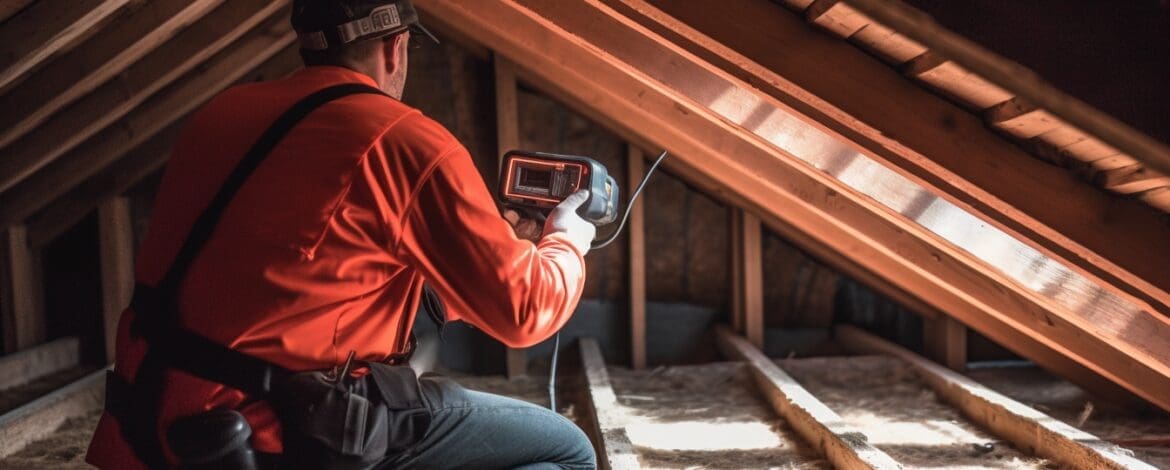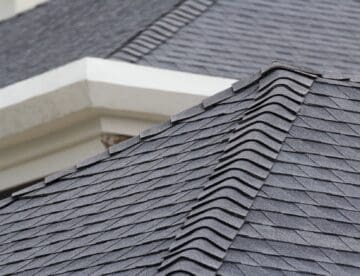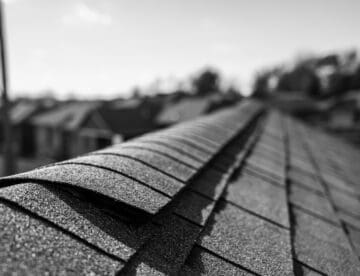A FLIR (Forward Looking InfraRed) camera can make finding hidden roof leaks much easier. As any homeowner knows, roof leak detection is incredibly challenging. Moisture and water damage often go undetected until it’s too late, leading to costly repairs. However, a FLIR camera uses thermal imaging technology to detect temperature differences. This means it has the potential to detect areas of moisture and potential leaks in a roof.
The challenge with finding the source of leaks is that water travels away from the damage. So, brown patches on ceilings are rarely an indicator of where the roof is leaking. This makes finding the source of a leak even more difficult, as there may be no visible signs of moisture on the roof.
This is where infrared imaging is useful for roof inspections. A FLIR camera can quickly and accurately identify roof leaks before they cause major damage. So, a small investment could potentially save you thousands of dollars on roof repairs.
In this article, you will learn how to use a FLIR camera to find hidden water leaks in your roof. You will also find out when to call a professional after discovering your roof leaks.
Understanding FLIR Cameras
A FLIR camera uses infrared thermal imaging to show visually the temperature emitted by objects. The camera reveals the amount of thermal energy in a grayscale or color format. Different shades or colors represent different temperature ranges.
FLIR cameras are useful for DIY leak detection, moisture detection, and identifying insulation issues. As the sunlight fades, dry areas of the roof cool down slower than damp areas, which cool down faster.
So, water evaporation or internal humidity causes temperature changes that a FLIR thermal imaging camera can pick up. Therefore, detecting hidden water damage, leaks, or areas prone to condensation is relatively straightforward.
The physics is simple — dry roof insulation heats up and cools down faster than wet roof insulation.
Additionally, FLIR images can identify cracks or openings in the roof structure where heat is escaping. This also helps you identify potential insulation issues so that you can take swift action to repair any roof damage.
Why Use FLIR Cameras for Roof Leak Detection?
FLIR cameras are easy to use and instantly identify areas of excessive moisture in roofs. Traditional roof inspections can be costly and time-consuming, usually requiring inspecting the roof for visible signs of damage. In some cases, invasive techniques, such as cutting into the roof, are necessary.
On the other hand, FLIR cameras are non-invasive; even a novice can use one for preventative maintenance and moisture detection. Additionally, there is no need to tear down drywall, remove insulation, or damage the structure to find leaks in the roof.
However, a DIY roof inspection with a thermal imaging camera goes beyond finding a leak. It’s useful for assessing the extent of moisture damage in an attic or roof space.
Here are a few more reasons why using taking FLIR images of your roof space is useful:
- Preventative maintenance: FLIR cameras help identify potential weak spots or areas of moisture damage in the roof before it becomes a major problem. This allows you to take swift action and prevent extensive repairs.
- Save money on repairs: Fixing a few broken shingles or repairing a facing is cheaper than a complete roof replacement. Long-term, unseen moisture issues can cause dampness, mold, and rot, which result in costly repairs.
- Save money on regular home inspections: If you have a thermal imaging camera, you can save money on frequent roof inspections. For example, roofs in Florida are subject to extreme weather conditions. Therefore, inspecting your roof for damage after a storm or hurricane is easier than calling a roofing contractor.
Related reading: How to find roof leaks.
How to Use FLIR Cameras to Find Roof Leaks
The best time to conduct a roof inspection with a FLIR camera is after sunset. Remember, an infrared imaging camera cannot see moisture in walls. It detects leaks and moisture issues due to subtle changes in temperatures. Therefore, you should check for leaks when the roof is cooling down.
Here is what you should do:
- Follow the manufacturer’s instructions to calibrate the camera.
- Use the camera to scan walls, ceilings, and attic spaces — any area where you suspect excess moisture accumulates.
- Look for anomalies in the FLIR images. Typically, excessive moisture from leaky roofs or flooding appears as dark colors.
- Mark areas where excessive moisture is detected. This will help when consulting with a roofing professional to arrange a roof repair.
- After confirming the leaks, see if fixing the damage is possible. However, in most cases, getting a professional contractor to repair the roof damage is advisable.
Thanks to Florida’s hot, humid climate, infrared scanning is an effective way to check for leaks. Typically, there are greater temperature differences between dry and wet areas as the buildings cool down at night.
It’s also good to remember that conditions must be right for results to be accurate.
Here are a few things to remember when inspecting your roof:
- Inspect the roof after a clear sunny day.
- Ensure the roof surface is dry.
- Remember that HVAC units or wet flat-roof drains can make the roof appear warmer in FLIR images.
- Cool roofs or reflective surfaces may appear wet.
Interpreting FLIR Camera Images
Interpreting FLIR camera images can be tricky. Generally, most anomalies will appear as dark colors in the images. Therefore, dark blue, purple, or black patches require further investigation.
At the same time, you can also check for heat loss around windows, doors, and crawl spaces. Red colors around these areas could indicate you must improve your home’s insulation.
When to Call a Professional
A FLIR camera is useful for identifying moisture damage caused by roof leaks or floods. It can help you identify weak spots and potential leaks. With this knowledge, you can repair roof damage before it becomes a major issue. Additionally, you can assess the insulation quality of your home.
Suppose you have used a FLIR camera to inspect your roof and found evidence of leaks. In that case, it’s time to call a trusted roofing contractor in your area. A professional can inspect the roof structure, identify where the location of the leak, and carry out necessary repairs.
Code Engineered Systems is the roof inspection and repair experts in the Tampa Bay, FL, area. Our experienced team will be able to quickly identify the source of your roof leak and provide you with an effective solution.Don’t wait until your roof becomes damaged beyond repair; contact us today for a free quote on a roof inspection or repair.




